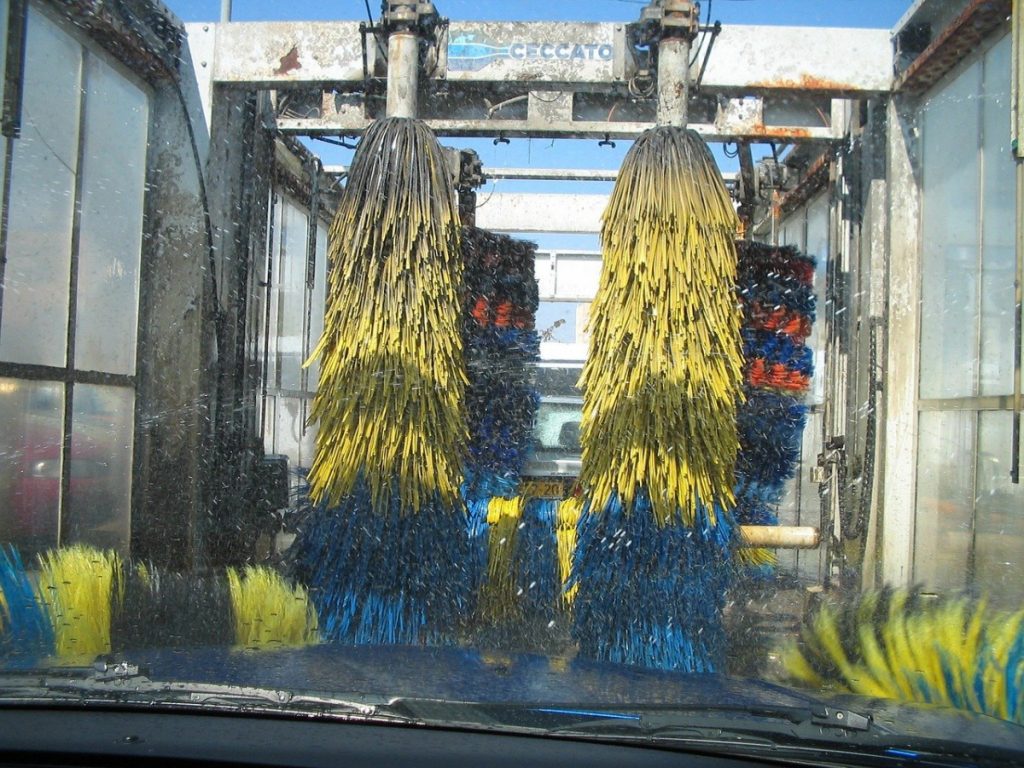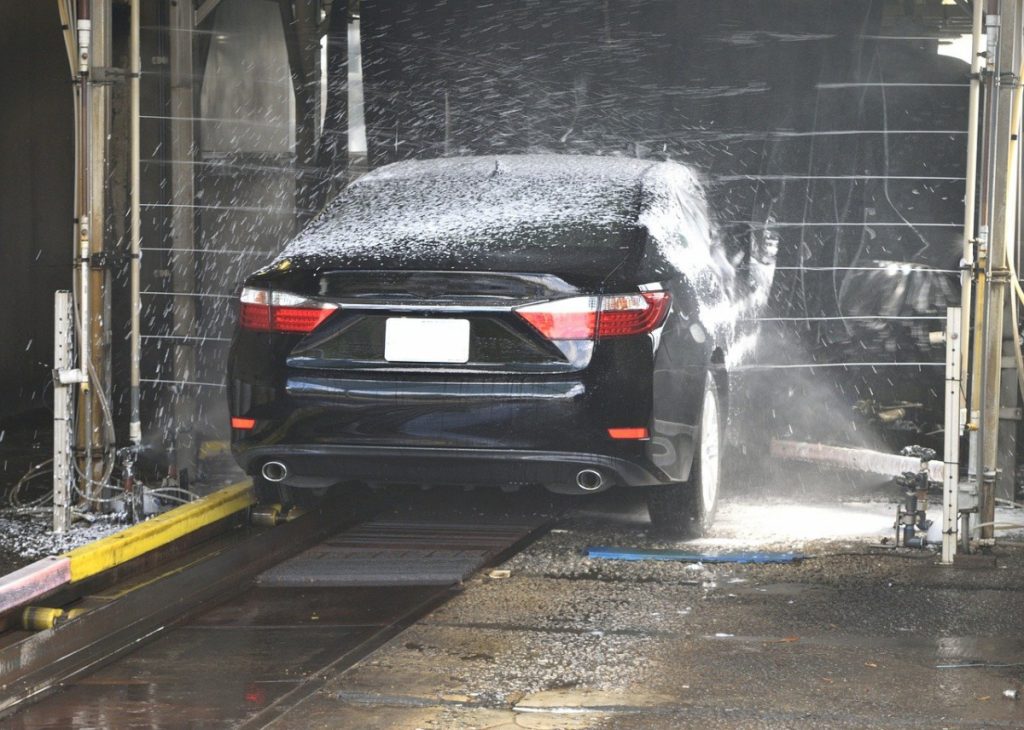Automatic car washes have a reputation for being aggressive and harmful to a car’s paintwork. But are these claims true, and what are the alternatives?
In this article, I’ll be addressing this question in a fair bit of detail so you know how to best look after your vehicle. So let’s get started.
The Quick Answer
Automatic car washes will damage a car’s paint by inflicting scratches in the clear coat caused by the use of harsh bristles and grit build-up on the brushes and foam. Automatic car washes also often use aggressive chemicals which can degrade and dry out the paintwork, causing damage over time.
Next, we’ll take a deeper look at the four issues with automatic car washes, and delve into the safer alternatives.

Issue 1: Harsh Brushes
The first issue with automatic car washes, is the actual brushes they use. They are often very coarse and scratch the paintwork with a single swipe. Some automatic car washes use “softer” materials, however, these are often still not soft enough to actually make contact with the paintwork without causing damage.
The truth is, the paint on a car is surprisingly delicate.
So delicate in fact, that even running your finger across it is likely to cause “clear coat scratches” or “swirl marks”. These are very fine scratches caused by friction that predominantly occurs during the wash process. The car’s paint consists of several layers, the top one being the clear coat, and the one underneath being the base coat which provides the car’s colour.
Here’s what these kind of scratches look like.


They aren’t often visible in low-level lighting, but as soon as a bit of direct sunlight hits the car, they stick out like a sore thumb.
Even though they can’t really be clearly seen on a cloudy day, they do reduce the overall clarity of the paintwork causing it to look dull in any kind of lighting. So if you want a shiny car, these type of scratches are your worst enemy.
Issue 2: Grit and Dirt Build-Up
The second issue with all types of contact-automatic car washes, is that tonnes of dirt and grit builds up on the brushes and flaps that get scraped over the paint.
Yes, they do get a rinse after each vehicle passes through the tunnel, but not a good enough one. Dirt and grit are very abrasive so removing them cautiously with minimal pressure is essential.
If you rub this dirt into the paint, then it will almost certainly cause clear coat scratches. Since the tools used in this automatic car washes are not cleaned thoroughly, it’s highly likely this will occur the next time you go through the tunnel.
Think about it, if you see a filthy pickup truck go through the car wash before you, then all that mud, sand and grit that’s been removed, will essentially be grinded into your car’s paint. Not great.
Issue 3: High Level of Force
The next issue with automatic car washes that really ties the previous two faults together, is the excessive use of force that they exert on the paintwork. In order to be powerful enough to tackle the build-up of mud that’s accumulated on a car for months or even years, automatic car washes require a certain level of pressure.
This pressure, when combined with harsh bristles and dirt build-up, essentially creates a recipe for scratching the paintwork.
The brushes/ cloth cylinders rotate of speeds of around 100 revolutions per minute, which is a pretty efficient way to scratch up the clear coat.
Issue 4: Aggressive Chemicals
An issue with automatic car washes that’s less talked about, is the damage that the often harsh chemicals they use can cause over time. This is true of many touchless automatic car washes as well.
These automatic car washes often use cleaning products with a very high (strong alkalis) or low pH (strong acids). These harsh chemicals will degrade and dry out the clear coat over time, especially if not rinsed away thoroughly enough.
What about Soft-Cloth Washes?
Unfortunately, “soft-cloth” automatic car washes suffer from the same issues that car washes which used stiff bristles suffer from. Harsh chemicals and a build up of dirt and grit on the “soft” foam strands, is a recipe for clear coat damage.
Also, even though they are described as “soft”, they aren’t really soft enough to be safely used on paintwork. In fact, the only material that is soft enough to avoid scratching the paint for sure, is microfiber. And only microfiber with a 70/30 polyester: polyamide blend is safe enough on very soft paintwork often found on Mazda, Porsches and Hondas.

What about Touchless Car Washes?
Touchless car washes are the safest option in the family of automatic car wash solutions. However, they do unfortunately still present a few issues:
- They use very harsh chemicals to replace brushes which can still degrade the paint.
- High pressure water will send dirt and debris flying across the paint causing it to scratch it along the way.
- The combination of harsh chemicals and water pressure will strip any paint protection such as waxes, sealants and coatings that may be on the vehicle.

What Should You Do Instead?
Okay, so if automatic car washes and touchless car washes are dangerous in a lot of cases towards the paintwork, what should you do instead?
Hand washing is by far a safer option that automatic car washes. Hand washing avoids problems such as using excessive force, harsh materials and aggressive chemicals which automatic and touchless washes suffer from. This helps to prevent scratches and clear coat degradation.
But, before you grab your bucket and sponge, be wary that that is often just as bad.
In fact, the vast majority of car owners are scratching their car every time they wash it at home, or take it to a cheap roadside hand wash station.
Here are some tips to keep in mind:
- Use a microfiber wash mitt instead of a sponge.
- Use a pressure washer held around 1 meter away from the paint to remove as much dirt as possible before touching the car.
- Wash the wheels using separate tools and buckets to the paint.
- Use a dedicated car shampoo, and never dish soap, bleach or other household products.
- Lubricate the paintwork as much as possible using car shampoo whenever you touch it.
- Rinse and dry by using a microfiber towel, never a bath towel, water blade or chamois leather.
Check out this complete guide to washing your car without causing scratches.
Thanks for reading! I hope you’ve found this article useful. Don’t forget to check out these other articles on car washing.

